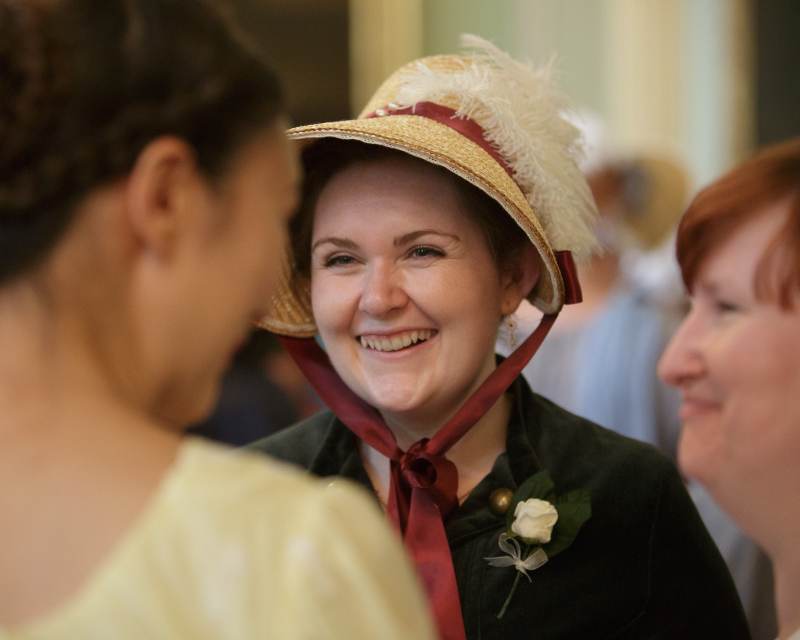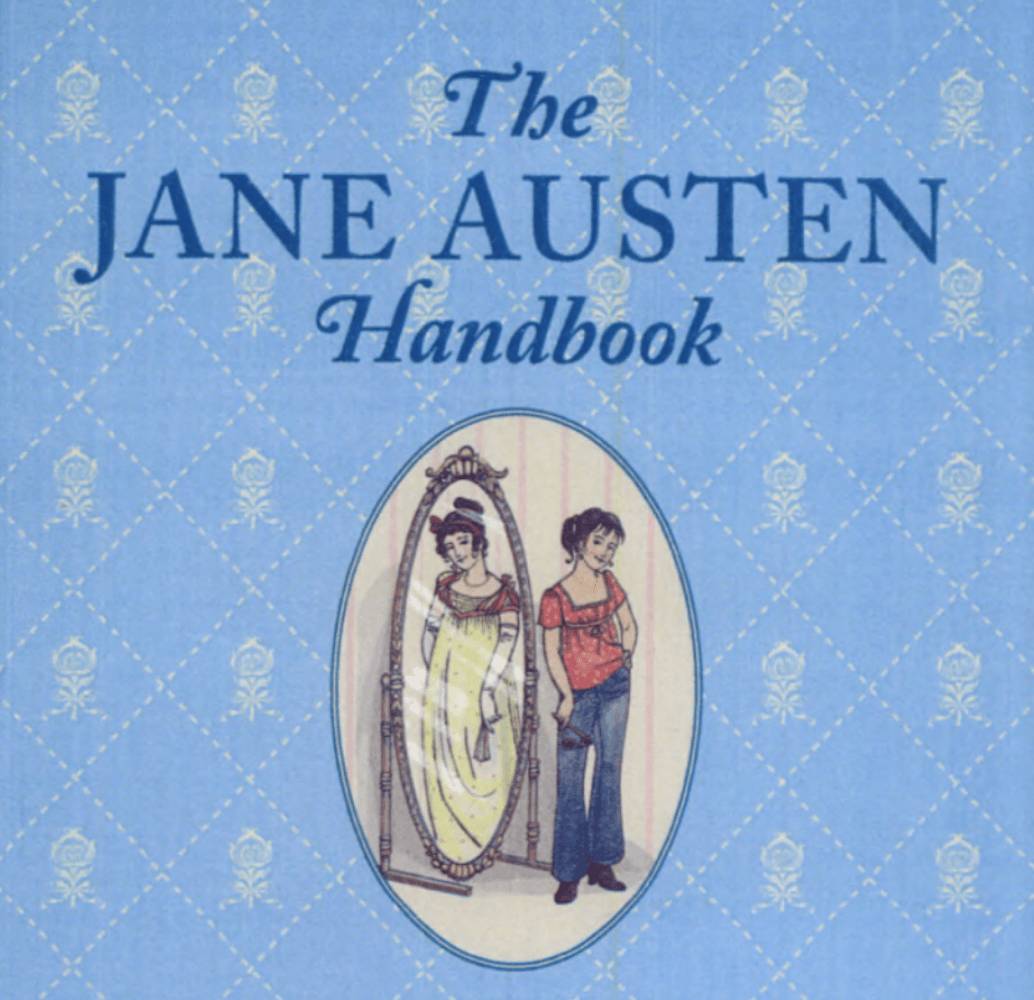
Paying Social Calls
By the beginning of the 19th century, the etiquette of calling was a firmly established ritual in society, and the calling card an essential part of introductions, invitations and visits. Calling cards evolved in England as a way for people to get into the elite social circle, and for those already there to keep out the unwanted. Calling cards could keep social aspirants at a distance until they could be properly screened.She reached the house without any impediment, looked at the number, knocked at the door, and inquired for Miss Tilney.
The man believed Miss Tilney to be at home, but was not quite certain.
Would she be pleased to send up her name?
She gave her card.
In a few minutes the servant returned, and with a look which did not quite confirm his words, said he had been mistaken, for that Miss Tilney was walked out.
Catherine, with a blush of mortification, left the house.
She felt almost persuaded that Miss Tilney was at home, and too much offended to admit her; and as she retired down the street, could not withhold one glance at the drawing-room windows, in expectation of seeing her there, but no one appeared at them.
Northanger Abbey

The Cards
A lady's card was larger than a gentleman's, who had to fit his in his breast pocket. Cards during the Regency era were smaller than the 9 x 6 cm of the Victorian era. A lady's card might be glazed, while her husband's was not. The engraving was in simple type, small and without flourishes, although script became more elaborate as the century went on. A simple 'Mr.' Or 'Mrs.' before the name was sufficient, except in the case of acknowledgement of rank (Earl, Viscount, etc.). Early Victorian cards bore only a person's title and name, with the name of their house or district sometimes added.
By the end of the century, the address was added to the card, and when applicable, a lady's reception day. Visiting card cases were made of a variety of materials, including silver, ivory and papier-mache. Their lids during the 1830s often depicted views of castles, such as Warwick or Windsor. By the 1840s, after Queen Victoria's purchase of Balmoral, Scottish views became popular. Cases during the Regency were primarily of filigree, leather and tortoiseshell. Victorians preferred ivory, tortoiseshell and woodwork. Because gold and other metals were expensive, only the wealthy could afford cases made of these substances. Victorian cards were larger than their earlier counterparts, so only a few were carried at a time.
Rules for Calls and Leaving Cards
A lady would start making calls as soon as she arrived in Town, to notify everyone that her family had arrived. She remained in her carriage while her groom took her card and handed it in. The card was conveyed to the mistress of the house, who would then decide whether or not to receive the caller. If the mistress was 'not at home', it was a rejection of the visitor. A reciprocal card may be given to the caller, but if not presented formally, that usually meant there was no desire to further the acquaintance. If, however, a formal call was returned with a formal call, there was hope for the relationship to grow.  Cards from visitors were placed on a silver salver in the entry hall--the more impressive names displayed on top. The trays had a pie-crust rim so the cards would not slip off. In less wealthy households, china bowls were used to hold cards.
Cards from visitors were placed on a silver salver in the entry hall--the more impressive names displayed on top. The trays had a pie-crust rim so the cards would not slip off. In less wealthy households, china bowls were used to hold cards.
For a first call, one was wise to simply leave the card without inquiring as to whether or not the mistress was at home. She would then take the next step. By mid-century, a wife could leave her husband's card for him. She left her own card, plus two of her husband's--one for the mistress of the house, and one for the master. The names of grown-up daughters could be printed on her card when they accompanied her on a call as long as they were still living at home. A turned-down corner indicated that the card had been delivered in person, rather than by a servant. Some elaborate cards had the words Visite, Felicitation, Affaires, and Adieu imprinted on the reverse side, on the corners. So whichever corner was turned up, one of those corners appeared and explained the reason for the visit.
Calls should be made only on At Home days. Days and times for these were engraved on visiting cards. A newcomer waited until she received cards from neighbors. It was then good manners to call on those neighbors who left cards. Formal calls were made following ceremonial events such as marriage or childbirth, and also as acknowledgement of hospitality. Calls for condolence and congratulations were made about a week after the event. If intimate, a visitor may ask for admission. If not, they inquired of the servant as to the person's well-being. Ceremonial visits were made the day after a ball, when it sufficed to simply leave a card. Or within a day or two after a dinner party, and within a week of a small party.
Times were allocated for each type of call. 'Morning calls' were made in the afternoon. 'Ceremonial calls' were made between three and four o'clock, semi-ceremonial between four and five, and intimate calls between five and six--but never on Sunday, the day reserved for close friends and relatives. Visits were short, lasting from twenty to thirty minutes. If another caller arrived during a visit, the first caller left within a moment or two. A call should be returned with a call, a card with a card, within one week, or at the most, ten days. If a family was temporarily leaving the area, they wrote P.P.C. (pour prendage conge) on their cards when they called.
 An in-depth look at paying and receiving Morning Calls can be found in Isabella Beeton's 1861, Mrs Beeton's Book of Household Management. This book was revolutionary in providing young wives with a quick reference guide to all aspects of running a household and covers everything from grocery shopping to menu planning, child rearing, becoming a gracious hostess and servant management. The fine art of paying calls had come into full bloom during the Regency and little had changed by the time Mrs. Beeton penned her indispensable manual.
An in-depth look at paying and receiving Morning Calls can be found in Isabella Beeton's 1861, Mrs Beeton's Book of Household Management. This book was revolutionary in providing young wives with a quick reference guide to all aspects of running a household and covers everything from grocery shopping to menu planning, child rearing, becoming a gracious hostess and servant management. The fine art of paying calls had come into full bloom during the Regency and little had changed by the time Mrs. Beeton penned her indispensable manual.
"After luncheon, morning calls and visits may be made and received. These may be divided under three heads: those of ceremony, friendship, and congratulation or condolence. Visits of ceremony, or courtesy, which occasionally merge into those of friendship, are to be paid under various circumstances. Thus, they are uniformly required after dining at a friend’s house, or after a ball, picnic, or any other party. These visits should be short, a stay of from fifteen to twenty minutes being quite sufficient. A lady paying a visit may remove her boa or neckerchief; but neither her shawl nor bonnet. When other visitors are announced, it is well to retire as soon as possible, taking care to let it appear that their arrival is not the cause.
When they are quietly seated, and the bustle of their entrance is over, rise from your chair, taking a kind leave of the hostess, and bowing politely to the guests. Should you call at an inconvenient time, not having ascertained the luncheon hour, or from any other inadvertence, retire as soon as possible, without, however, showing that you feel yourself an intruder. It is not difficult for any well-bred or even good-tempered person, to know what to say on such an occasion, and, on politely withdrawing, a promise can be made to call again, if the lady you have called on, appear really disappointed. In paying visits of friendship, it will not be so necessary to be guided by etiquette as in paying visits of ceremony; and if a lady be pressed by her friend to remove her shawl and bonnet, it can be done if it will not interfere with her subsequent arrangements. It is, however, requisite to call at suitable times, and to avoid staying too long, if your friend is engaged.
The courtesies of society should ever be maintained, even in the domestic circle, and amongst the nearest friends. During these visits, the manners should be easy and cheerful, and the subjects of conversation such as may be readily terminated. Serious discussions or arguments are to be altogether avoided, and there is much danger and impropriety in expressing opinions of those persons and characters with whom, perhaps, there is but a slight acquaintance. It is not advisable, at any time, to take favourite dogs into another lady’s drawing-room, for many persons have an absolute dislike to such animals; and besides this, there is always a chance of a breakage of some article occurring, through their leaping and bounding here and there, sometimes very much to the fear and annoyance of the hostess. Her children, also, unless they are particularly well-trained and orderly, and she is on exceedingly friendly terms with the hostess, should not accompany a lady in making morning calls. Where a lady, however, pays her visits in a carriage, the children can be taken in the vehicle, and remain in it until the visit is over.
For morning calls, it is well to be neatly attired; for a costume very different to that you generally wear, or anything approaching an evening dress, will be very much out of place. As a general rule, it may be said, both in reference to this and all other occasions, it is better to be under-dressed than over-dressed. A strict account should be kept of ceremonial visits, and notice how soon your visits have been returned. An opinion may thus be formed as to whether your frequent visits are, or are not, desirable. There are, naturally, instances when the circumstances of old age or ill health will preclude any return of a call; but when this is the case, it must not interrupt the discharge of the duty. In paying visits of condolence, it is to be remembered that they should be paid within a week after the event which occasions them. If the acquaintance, however, is but slight, then immediately after the family has appeared at public worship. A lady should send in her card, and if her friends be able to receive her, the visitor’s manner and conversation should be subdued and in harmony with the character of her visit.
Courtesy would dictate that a mourning card should be used, and that visitors, in paying condoling visits, should be dressed in black, either silk or plain-coloured apparel. Sympathy with the affliction of the family, is thus expressed, and these attentions are, in such cases, pleasing and soothing. In all these visits, if your acquaintance or friend be not at home, a card should be left. If in a carriage, the servant will answer your inquiry and receive your card; if paying your visits on foot, give your card to the servant in the hall, but leave to go in and rest should on no account be asked.
The form of words, “Not at home,” may be understood in different senses; but the only courteous way is to receive them as being perfectly true. You may imagine that the lady of the house is really at home, and that she would make an exception in your favour, or you may think that your acquaintance is not desired; but, in either case, not the slightest word is to escape you, which would suggest, on your part, such an impression. In receiving morning calls, the foregoing description of the etiquette to be observed in paying them, will beof considerable service. It is to be added, however, that the occupations of drawing, music, or reading should be suspended on the entrance of morning visitors.
If a lady, however, be engaged with light needlework, and none other is appropriate in the drawing-room, it may not be, under some circumstances, inconsistent with good breeding to quietly continue it during conversation, particularly if the visit be protracted, or the visitors be gentlemen. Formerly the custom was to accompany all visitors quitting the house to the door, and there take leave of them; but modern society, which has thrown off a great deal of this kind of ceremony, now merely requires that the lady of the house should rise from her seat, shake hands, or courtesy, in accordance with the intimacy she has with her guests, and ring the bell to summon the servant to attend them and open the door."
***
This article was written by Michelle Hoppe Prima for Literary Liaisons, an author run website devoted to Regency and Victorian history. Ms Prima is an award winning author in her own right, with several titles to her credit. She lives in Chicago with her husband, two daughters and five dogs.
Sources for this article include:
Visiting Cards and Cases by Edwin Banfield, Baros Books, Wiltshire, 1989. ISBN#0948382031
What Jane Austen Ate and Charles Dickens Knew by Daniel Pool, Simon & Schuster, New York, 1993 ISBN#0671793373
The Writer's Guide to Everyday Life in Regency and Victorian England From 1811-1901 by Kristine Hughes, Writer's Digest Books, Cincinnati, 1998. ISBN#0898798124
The Model Wife, Nineteenth-Century Style by Rona Randall, The Herbert Press, London, 1989. ISBN#0906969840
If you don't want to miss a beat when it comes to Jane Austen, make sure you are signed up to the Jane Austen newsletter for exclusive updates and discounts from our Online Gift Shop.



1 comment
Funny that it was better to be under-dresse than over-dresse. Quite the opposit today (at least here in Denmark).
Manne
Leave a comment
This site is protected by reCAPTCHA and the Google Privacy Policy and Terms of Service apply.